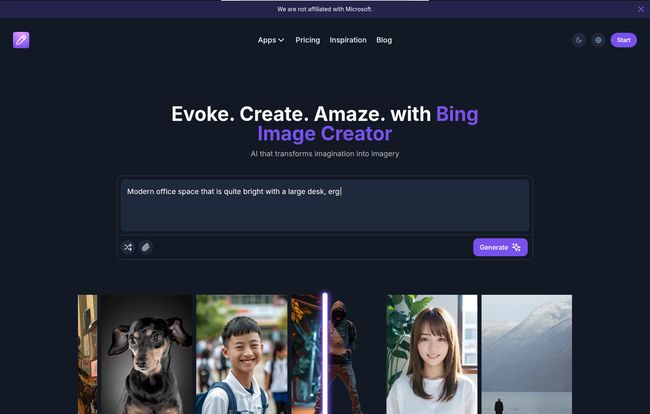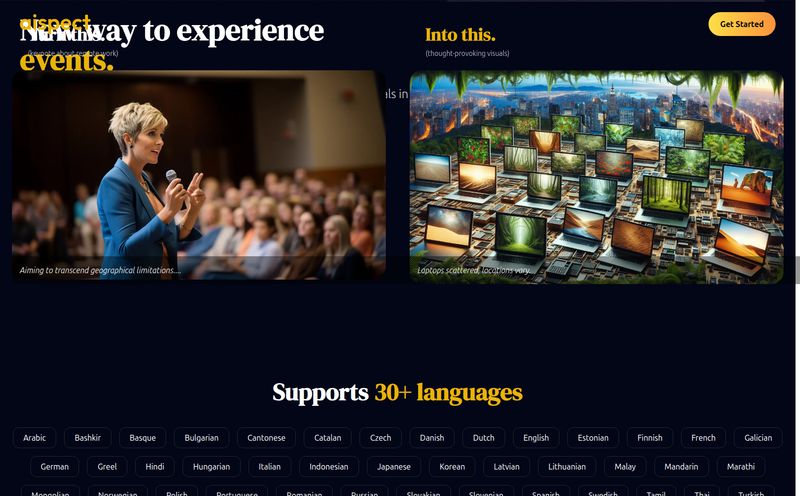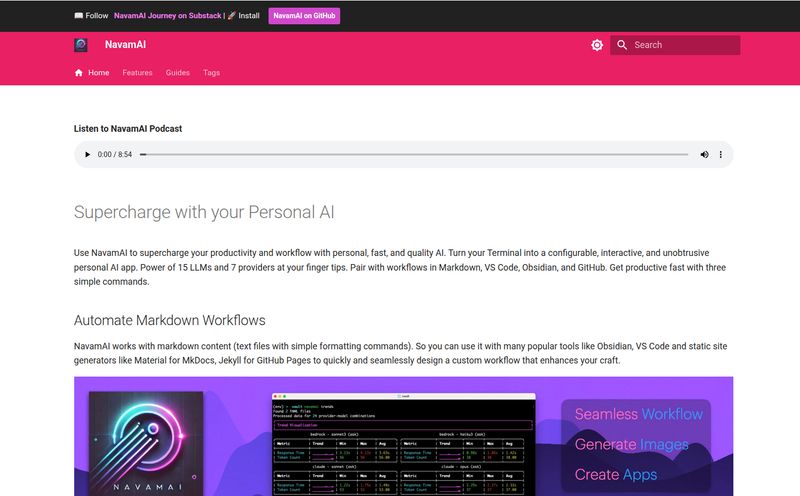The world of AI image generation is absolutely exploding right now. It feels like every other week there's a new tool that promises to turn your wildest thoughts into photorealistic (or wonderfully weird) images. It's a gold rush for creatives, marketers, and honestly, anyone who just wants to see what a "Corgi riding a skateboard on Mars, impressionist style" looks like. Spoiler: it's amazing.
In the middle of all this noise, you've probably heard the name 'Bing Image Creator'. Microsoft threw its hat in the ring, powered by the seriously impressive DALL-E 3 model. But today, we’re looking at a specific platform: bingimagecreator.net. It's got the name, it’s got a slick dark-mode interface, and it promises to make AI art easy. But is it the one you're thinking of, and more importantly, is it any good? I’ve spent the last few days kicking the tires, burning through credits, and I’ve got some thoughts. Let’s get into it.
First Impressions: What is This Thing?
Landing on the homepage, you’re greeted with a bold statement: "Evoke. Create. Amaze." I like the confidence. The page is plastered with gorgeous, high-quality examples of what the AI can do—from stunning portraits to whimsical Disney-style movie posters. It’s all very enticing.
At its heart, this Bing Image Creator is a web-based platform designed to do one thing very well: create images from your text descriptions. But it's also packing a few extra tools in its backpack, like an AI photo editor, background remover, and even an AI headshot generator. It’s trying to be a bit of a Swiss Army knife for quick visual content creation.

Visit Bing Image Creator
Getting Started: Is It Really That Easy?
The site boasts a simple three-step process: 1. Fill the form. 2. Click to Generate. 3. Wait for the magic. And you know what? It’s pretty much that straightforward. The user interface is clean, uncluttered, and focuses you on the main task: writing a great prompt. You type what you want in a box, pick a style if you feel like it, and hit the button. No complicated settings or a million sliders to figure out. It feels accessible, which I think is a huge win for people who are maybe a little intimidated by more complex platforms like Midjourney.
I threw a few test prompts at it. Something simple like "a cozy library in a treehouse, rainy day, warm lighting" and something a little more out there. The results came back reasonably fast, and for the most part, they were pretty impressive. The quality is definitely there.
The Full Toolkit: More Than Just a Prompt Box
This is where the platform tries to stand out from the crowd. It's not just a one-trick pony. Let's break down the creative arsenal it gives you.
The Main Event: AI Text-to-Image
The core generator is solid. It seems to understand nuance pretty well. The inspiration gallery on the front page is actually a fantastic resource. Seeing what other people have created—and the prompts they used—is an excellent way to learn how to 'talk' to the AI to get what you want. Sometimes, half the battle is just figuring out the right words to use.
Exploring the Fun AI Artistry Styles
This is my favorite part. The platform comes with pre-baked style filters that are just plain fun. The Disney AI Poster style is all over social media for a reason, and this tool lets you jump right on that trend. I spent way too much time turning my pets into Pixar characters. There’s also a Studio Ghibli style filter, which creates those dreamy, beautiful, and slightly nostalgic scenes that Hayao Miyazaki is famous for. For social media content creators or people just looking to make a unique profile picture, these filters are absolute gold.
The Handy Editing Suite
Beyond just creating new images, you get a handful of editing tools. There's an AI Upscaler to increase the resolution of your creations, a Magic Eraser to remove unwanted objects (goodbye, photobombers!), and a background remover. These are genuinely useful features that save you from having to take your generated image into another program like Photoshop or Canva to make basic edits. It's a smart move to keep you inside their ecosystem.
Let's Talk Money: The Pricing and Plans
Alright, this is the big one. The tool is advertised as free, and it is... sort of. Like many AI services, it runs on a credit system. Here’s how it breaks down.
| Plan | Price | Credits | Key Features |
|---|---|---|---|
| Free | $0 /Mo | 15 credits for the first week | Standard generation, access to tools. No commercial license. |
| Stater | $18 /Mo (usually $29.99) | 300 credits per month | Fast generation, No watermark, Commercial license, Priority queue. |
| Pro | $36 /Mo (usually $59) | 1000 credits per month | All Stater features, plus more credits. |
The free plan is generous enough to let you get a real feel for the tool. The site says you get 15 credits for your first week, which is plenty for experimentation. The biggest, most glaring catch for any professional is the lack of a commercial license on the free plan. This means if you create an image, you can't legally use it for your blog, your business's social media, or any project that makes money. For personal use and fun? Go wild. For business? You've got to pay up.
The paid plans—Stater and Pro—are where this becomes a viable tool for marketers, bloggers, and small businesses. For $18 a month, getting 300 images with a commercial license, no watermark, and faster processing is actually a pretty competitive deal in the current market.
The Good, The Bad, and The... Coming Soon
So after all that, what’s the verdict? No tool is perfect, and this one has its quirks.
What I love is its simplicity. It’s an incredibly low barrier to entry for creating some genuinely beautiful AI art. The specialised filters are a fantastic touch, and the suite of editing tools adds real value. It’s a great one-stop-shop for quick creative tasks.
On the flip side, the credit system on the free plan will feel limiting if you get hooked. And the commercial rights issue is a deal-breaker for any professional use on the free tier. One funny little detail I noticed is that, according to their own FAQ, the feature to delete images you've created is still “under development”. It’s a small thing, but it’s a very human reminder that these platforms are all works in progress. It's kinda charming, in a way.
A Quick Note on the Name Game
Here's where my SEO-spidey sense starts tingling. It's important to be clear: bingimagecreator.net is a standalone website. The official Microsoft tool is integrated directly into its search engine and is found at bing.com/create. It's powered by OpenAI's DALL-E 3. Does this third-party site also use the Bing API? Maybe. But they are not the same entity. This matters for things like terms of service, data privacy, and who you're actually giving your information to. I'm not saying one is better than the other, but it’s an important distinction to make. Always be aware of which service you’re actually using.
So, Should You Use This Bing Image Creator?
I think the answer is a solid “it depends on who you are.”
If you’re a hobbyist, a student, or just curious about AI art and want to create some cool images for personal projects without a steep learning curve, absolutely. Dive in. The free plan is perfect for you to experiment and have a ton of fun. Go make that Disney poster of your cat.
If you’re a marketer, a blogger, or a small business owner looking for a quick and affordable source of unique, commercially-usable images, the paid plans are genuinely worth considering. The price for the Stater plan is very reasonable for what you get, especially with the added editing tools. It could easily save you a ton of time and money on stock photos.
Frequently Asked Questions
Can I upload and modify my own photos with this tool?
Yes, the platform includes AI photo editing features that allow you to upload your own images for things like background removal, object erasing, or applying cartoonizer effects.
How do I save the images that I create?
Once an image is generated, you can typically click on it to see a larger view, where you'll find a download button to save the file directly to your device.
Are the images I make on the free plan really free to use?
They are free for personal, non-commercial use. This is a critical distinction. If you want to use an image for a business blog, marketing, or any for-profit venture, you need to upgrade to a paid plan to get the commercial license.
What happens if I run out of credits on my subscription?
If you use up your monthly credits on a paid plan, you'll likely need to wait until the next billing cycle for them to reset. Some services offer top-up credit packs for purchase, though you'd need to check their dashboard for that option.
Is there a limit to how many images I can generate?
Yes, your generation is limited by your number of credits. Each image generation will consume one or more credits, depending on the specific task. Once your credits are gone, you have to wait for them to refresh or upgrade your plan.
Final Thoughts
Navigating the AI tool landscape can feel like trying to drink from a firehose. This particular Bing Image Creator carves out a nice little niche for itself. It’s not the most powerful or complex tool on the market, but it might be one of the friendliest and most straightforward. It prioritizes fun and accessibility, and its paid tiers offer a solid value proposition for professionals. It’s a great starting point for some and a handy, quick-fix tool for others. And in this fast-moving space, that's a pretty good place to be.
Reference and Sources
- Bing Image Creator Pricing and Dashboard
- The Verge: "Microsoft’s new DALL-E 3 tool is here to take on Midjourney" - For context on the official Microsoft tool.



